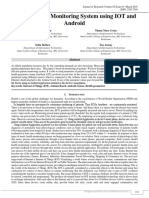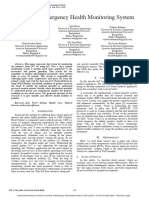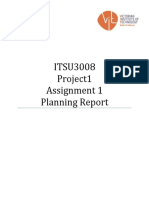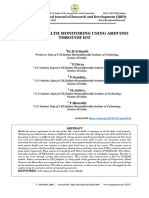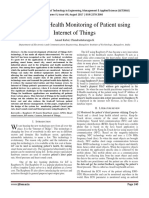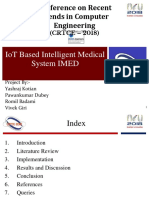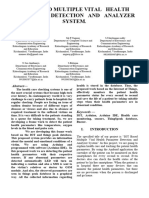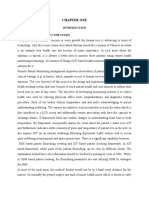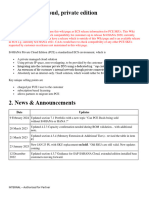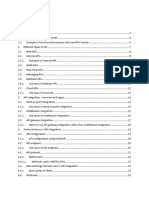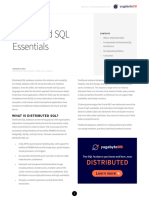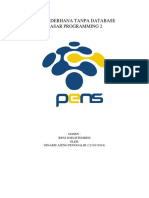2ND IOT PROJECT
1. Abstract
2. Introduction
3. Literature review
4. Discussion
5. Conclusion
Name:Avisapakam omkar
Team member name:Hemasri reddy
Tittle:
Iot in healthcare: patient monitoring and data management.
Abstract:
Health is most valuable resource of every human being. Hence it should give highest attention and care.
Due to increase in population, there arises huge demand to provide proper health-care services. Due to
the busy schedule, standard of living and food habits, health problems like diabetes, blood pressure, and
heart attack cases are increasing. Thus, there is need of a system using which people can monitor such
common health issues from home and visiting doctor for regular health check-up can be avoided. This
saves a lot of people's time. Detections of some symptoms can be done by using sensors. It delivers the
health-care services from remote patients to doctor. Cloud computing is gaining popularity for the way it
shares data. Hence it can be used to exchange data of health care systems. This is done using IOT, which
is used to connect the everyday things through internet. The cloud can store a large amount of data in its
database. The health parameter values are stored in cloud. The cloud maintains the records until the user
deletes it. It stores the health parameter values in the form of graph so it will be easy for the patient to
interpret his health issues. But the data sent to cloud is not secured and hence the private data of the
individual is at stake. Thus here, the security for cloud computing is provided to assure privacy. In this
paper, values of health parameter are obtained by the sensors and are sent to Arduino from which, it is
sent to cloud. Also Arduino displays these values on LCD display and has LED and buzzer module to
indicate severity. By this life of an individual is made even easier by collecting the health information
from the place wherever the patient is present and updating it to cloud so that the data can be retrieved,
anytime and anyplace.
� Keywords:Health-care services, Internet of Things (IoT), Cloud computing, Security, Privacy.
Introduction:
The internet of things has numerous applications in healthcare, from remote monitoring to smart sensors
and medical device integration. It has the potential to not only keep patients safe and healthy, but also to
improve how physicians deliver care as well and connects patients and physicians anytime which is
referred to as structured health monitoring (SHM).The sensor data can be accessed by the user anytime,
anywhere and it is crucial to provide security to the biomedical data. With the advancement in
technology and introduction of cloud technology the improvised framework is provided for the privacy
of the data .For mobile devices using WBAN(wireless body area network) that continuously collects the
medical data and send it to other mobile devices of the patients or doctors, which is connected to back
end server and database that securely stores the data and analyzes for generating required alerts.In real
time systems, a healthcare system is developed on android platform for low cost community. This
system collects physiological parameters of the patient continuously and send it to the PC on wireless
mode of transmission .UbiNurSS-Ubiquitous Nursing Support System is also developed for real time
health monitoring .To provide security to the cloud data a novel clustering algorithm can be used which
identifies threats and add some protocols to ensure the privacy of the data against the cloud threats .A
new security model for cloud which is into layers that can help cloud providers to identify privacy
issues, to make difference between different sources of threats and also to provide security .This paper is
organized asfollows. In section 2 Literature Survey is discussed. Proposed system and Experimental
Results are discussed in section 3 and 4 respectively.
Literature Review:
In this paper, it mainly concentrate on privacy model and cloud security which helps to identify and
classify different privacy issues and cloud security, necessary counter measurements are adopted. In this
paper algorithm have been developed to classify noise for BP signal and pulse oximetry which have
been recorded earlier, systolic and diastolic of BP signal are identified. Previously BP have been
estimated using only PTT by linear regression which may not reflect the actual relationship between BP
and PTT and susceptible to arterial regulation ,but in this paper cuff less BP estimation is using PTT and
PIR is done. temperature measurement of human body is done and updated using real time application
which even consists of alarm to notify the patient if any severity found. A device called Analog front
end is also used to measure temperature of human body in which threshold value of the temperature is
already fed into the device while coding.Heart rate is most vital indicator which provide information
about rhythm of the heart. In this paper heart rate is measure and kept securely which is the main issue
now a days. Current technology trends such as ubiquitous computing and calm technology, call for novel
Page 2
� unobtrusive sensors, it’s a commonly used monitoring technique. In the previous paper it needs patient
contact with the sensor, but in the present paper it doesn’t require patient contact with the device used
for the measurement of heart rate and Unobtrusive. As we all know that the security of the patient record
is an international problem. So the activities like exchange security, privacy and interoperability of
electronic medical record of health institution are secured using cloud computing using pattern and
password techniques .in this paper home health hub internet of things framework is proposed where by
using this device the health management of elderly people at home at very cheap rate and it’s very easy
to use with mobility. It can be used in clinical environment such as hospital diagnosis centre.
Proposed system:
The block diagram of health monitoring system is shown in fig 1. The block diagram consists of three
sensors such as Temperature sensor (LM35), Blood Pressure sensor (26PC SMT), and Heart Rate sensor
(TCRT1000).
Page 3
� Fig 1: Arduino & Iot based patient monitoring system
Page 4
� Fig: 2 functional diagram of security system
The health parameters are sent to cloud with security as shown in fig 2. The values received from the
sensors are fed to arduino with the help of interfacing unit. The arduino has inbuilt Wi-Fi module using
which it connects to internet. It encodes the data values before sending it to cloud to ensure security. It
sends the encrypted values to the cloud using IOT through a secured connection. These values are
compared with the threshold values in the data base. If there is any severity found, it sends an alert to the
doctor. If no severity found the received data from arduino are stored in database which can be retrieved
using a unique key by the patient anywhere and anytime. This reduces the pain of carrying the paper
records to the doctor and maintaining it. In this system the data cannot be manipulated by the third party
as it is secured. It also cannot be viewed by anyone without the unique password. The key can be
changed frequently by the user so that the data cannot be hacked.
Page 5
� Circuit diagram:
Experimental results:
The sensor values, which are converted to digital using interfacing unit i.e., MCP3008 are fed to
Arduino. These values are displayed on the LCD display. When the system is turned on, the LCD
displays "Health Monitoring System". When we press the first switch, & hold the finger on temperature
sensor, it displays the Temperature value. Similarly, when we press the second switch and third switch, it
displays blood pressure and heart rate values respectively when finger is held on the respective sensors.
Fig 3 shows heart rate value display on LCD.
Page 6
� Fig 3: Lcd display for heart rate.
The system also consists of LED display and buzzer to indicate if there is any severity found. The
arduino compares the sensor values with the normal range of that health parameter. If the readings are
within that range, the LED glows green and if there is slight change in the values, it glows yellow. In
both the cases, the buzzer is off. If the values crosses the normal range, the LED glows red and the
buzzer beeps to alert the user. Fig 4 shows LCD and LED display of temperature. Here the LED is
glowing red as the temperature value has crossed the normal range.
Discussion:
Healthcare is a vast arena that is composed of many different components. Delivering healthcare
involves clinical practices, hospitals, pharmacies, home health providers, long-term care providers,
pharmaceutical companies, and medical-device manufacturers. It also involves health and wellness
products and services, insurance companies, and governments providing services to end-users
This section provides a review with an analysis of the recent research on IoT-based
healthcare-monitoring systems summarizes some of the recent studies regarding IoT-based
healthcare-monitoring systems.
Page 7
� Conclusion:
In this paper, a health monitoring system is established using cloud computing with security. It aims at
providing a wireless, reliable health monitoring and warning system. Several devices in the market
including Arduino are used. The vital sign reading from the chosen device is value-added by further
analyzes forproviding real-time warnings. These systems can provide proactive health related alert. The
real-time message exchange between Arduino and web server is employed to logically connect both
sub-systems. The heart rate, body temperature and blood pressure are the chosen vital signs for
reflecting the patient’s health by comparing with the ranges defined by the nurses or the doctors. Here an
attempt to develop an innovative approach for handling privacy in the current service oriented model is
presented.
References:
[1] M. Elmisery, Seungmin Rho, and Dmitri Botvich (2017) IEEE "A Fog Based Middleware for
Automated Compliance with OECD Privacy Principles in Internet of Healthcare Things"
[2] Sourav Kumar Dhar, Suman Sankar Bhunia, Nandini Mukherjee (2014) Fourth International
Conference of Emerging applications of Information Technology, IEEE "Interference Aware Scheduling
of Sensors in IoT Enabled Health-care Monitoring System"
[3] Dr.B.Eswara Reddy, Dr. T.V.Suresh Kumar, Gandikota Ramu (2012) IEEE "An Efficient Cloud
Framework for Health Care Monitoring System"
[4] Ding Yi, Fan Binwen, Kong Xiaoming, Ma Qianqian (2013) IEEE "Design and Implementation of
Mobile Health Monitoring System based on MQTT Protocol"
[5] Ahmed Abdelgawad (2016) IEEE "Structural Health Monitoring: Internet of Things Application"
[6] Srijanee Biswas, Sohum Misra (2015) IEEE "Designing of a Prototype of e-Health Monitoring
System"
[7] Sanjana Babu, Chandini M, Lavanya P, Kirupa Ganapathy, V. Vaidehi (2013) IEEE "Cloud-Enabled
Remote Health MonitoringSystem"
[8] Nitha V Panicker, Sukesh Kumar A (2015) International Conference on Control, Communication &
Computing India IEEE"Real Time Monitoring of Vital Signals through Telemedicine for Community
Healthcare"
[9] Ittipong Khemapech (2015) IEEE "A Real-time Health Monitoring and Warning System"
Page 8
�Page 9



